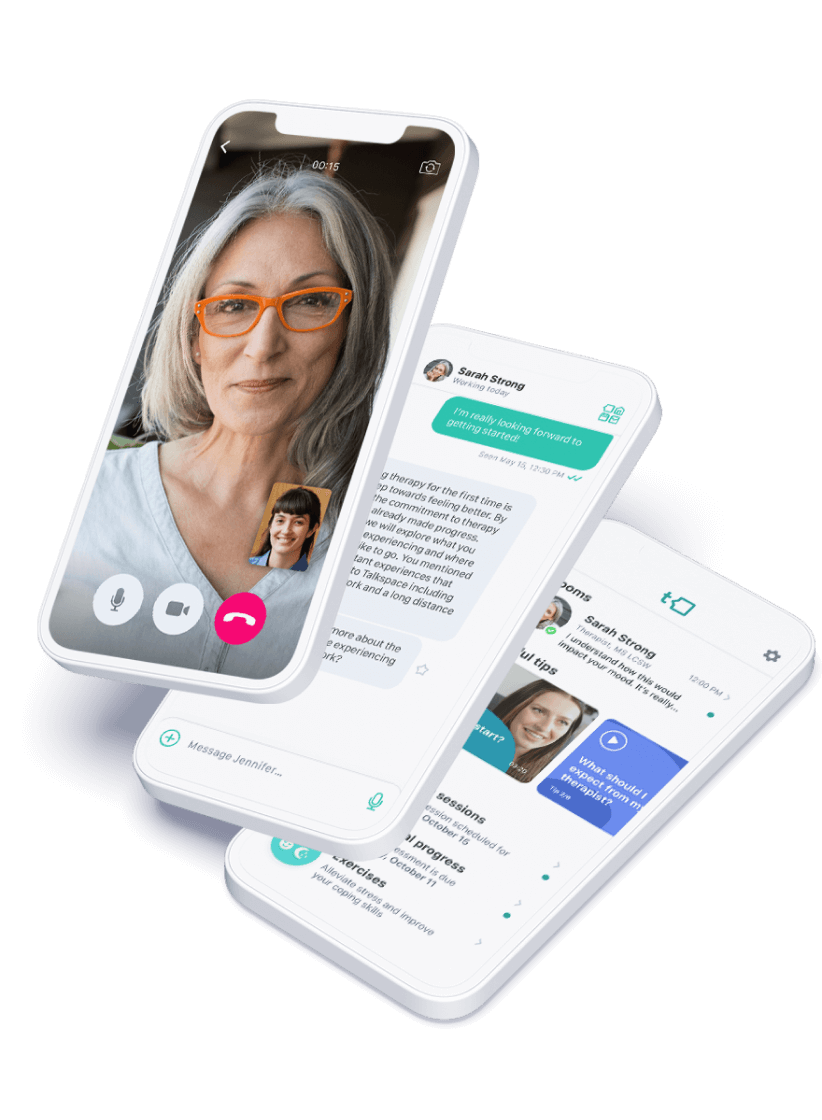Phobias
Read Time: 8 MinutesUpdated On: June 28, 2024
Overview
An estimated 40 million people in the United States live with an anxiety disorder of some kind. It’s the most common mental health condition in the country. Social anxiety disorder (SAD) and agoraphobia are types of anxiety disorders that can significantly impact daily life and relationships. While these conditions can both cause severe anxiety and share some similarities in symptoms, they manifest and are triggered in different ways. Understanding the differences between agoraphobia vs. social anxiety is critical in finding the most effective treatment plan.
The main difference between agoraphobia and social anxiety is that agoraphobia involves a fear of being in places or situations where escape might be difficult or help is unavailable during a panic attack, leading to avoidance of such environments, whereas social anxiety centers on the fear of being judged in social interactions, which significantly disrupts everyday activities.
Recognizing the characteristics of agoraphobia and social anxiety helps you get an accurate diagnosis. Without that, it’s difficult to start an effective treatment that can improve symptoms and enhance quality of life. In short, misdiagnoses can directly prevent treatment and effective management of these conditions. Keep reading to learn more about agoraphobia vs. social anxiety.
Defining Agoraphobia and Social Anxiety Disorder
Agoraphobia and social anxiety disorder both have anxiety-related symptoms that make it challenging for people to engage with others socially. Both frequently occur with other mental health conditions, too, which can further complicate treatment, especially if a proper diagnosis isn’t made.
What is Agoraphobia?
Agoraphobia, one of the most common phobias, causes a persistent, intense fear of places or settings where it might be hard to leave or get help during a panic attack. People with agoraphobia generally avoid crowded spaces, open areas, enclosed spaces they’re unfamiliar with, and long lines. They’re likely uneasy about public transportation or other environments where they can’t quickly and easily leave. Feeling trapped or helpless is a significant fear for people with this specific phobia.
The symptoms caused by agoraphobia can make daily functioning and interactions increasingly challenging. Their intense fear often leads to social isolation in an attempt to avoid triggers. Although agoraphobia can be debilitating, many people successfully manage their condition and regain control of their lives with a solid treatment plan that typically includes therapy and medication.
What is Social Anxiety Disorder?
Social anxiety disorder is characterized by an overwhelming fear of being embarrassed or rejected in social settings. It often includes fear of being judged or scrutinized, which can cause intense anxiety about ordinary, everyday activities.
It’s common to confuse social phobia vs. social anxiety, but social phobia has more to do with a specific phobia of things or situations, like performing in front of a crowd or giving a presentation. Social anxiety refers to extreme nervousness and fear of embarrassment when in group gatherings.
Although social anxiety can impair social functioning, most people can learn effective coping strategies to conquer their fear of being social with appropriate treatment, which typically involves therapy and medication.
Online therapy for anxiety
Get support for anxiety fast and reach a calmer mindset. Therapy for anxiety is covered by most insurance plans.
Key Differences Between Agoraphobia and Social Anxiety Disorder
While on the surface, these anxiety disorders seem strikingly similar, there are subtle differences that impact how they affect someone’s life and relationships. Understanding the distinctions between social anxiety disorder vs. agoraphobia is crucial.
Focus of fear
One of the main differences between these two conditions is the focus of fear someone experiences when they have one vs the other. People with agoraphobia fear being stuck somewhere and not being able to get help. On the other hand, people with social anxiety disorder are afraid of being judged or criticized by others.
“While both agoraphobia and social anxiety disorder both have their roots in fear, agoraphobia is more of a global fear of everything that leads to almost a paralysis in terms of someone’s ability to experience life. Social anxiety disorder is more focused on the fear of the socialization aspect, but otherwise, people can lead very full lives.”
Expert Insight
 Doctor of Psychology (PsyD.), Licensed Professional Counselor (LPC) Meaghan Rice
Doctor of Psychology (PsyD.), Licensed Professional Counselor (LPC) Meaghan Rice
Triggering situations
Triggers also vary for people with agoraphobia vs. social anxiety. For example, someone with agoraphobia can be triggered by an environment they think would be hard to escape from or places where they believe nobody would help them if they had a panic attack — like being in a big crowd where they don’t know anyone.
In contrast, someone with social anxiety disorder might be triggered by a social setting where they worry the spotlight might be on them. Meeting new people or being the center of attention opens them up to scrutiny and can be incredibly painful due to their extreme fear of embarrassment or criticism.
Symptoms
While the basic premise of symptoms can be similar — avoidance behavior and severe anxiety — people living with agoraphobia often have intense panic attacks as a result of their surroundings.
Common physical symptoms of agoraphobia include:
- Rapid heartbeat
- Sweating
- Trembling
- Shortness of breath
- Staying indoors
- Refusing to leave their home
Social anxiety disorder can manifest in any social situation where someone fears they will be judged negatively by those around them. As a result, it’s common for them to experience panic attacks or have intense anxiety before or during social interactions.
Physical symptoms of social anxiety disorder include:
- Blushing
- Sweating
- Trembling
- Difficulty speaking
- Shaking
- Social isolation
- Withdrawal
Nature of avoidance
Because of the distinct triggers and fears associated with these conditions, the nature of avoidance tactics differs, too.
Avoidance behaviors in people with agoraphobia revolve around environments and situations they perceive as hard to leave or find help. The biggest driver of fear is the possibility of having a panic attack and not being able to get help, so they may not get on that bus to go downtown or go into that crowded mall where they don’t know anyone.
With social anxiety disorder, avoidance behaviors are more centered on social environments that might lead to them being embarrassed, critiqued, or scrutinized. People with social anxiety disorder are often willing to go to great lengths to limit their exposure to what they consider to be threatening environments.
“Avoidance is where we make significant life alterations to eliminate anything and everything related to our specific trigger. For example, if we are scared of people, we would steer clear from any situations that include large groups of people.”
Expert Insight
 Doctor of Psychology (PsyD.), Licensed Professional Counselor (LPC) Meaghan Rice
Doctor of Psychology (PsyD.), Licensed Professional Counselor (LPC) Meaghan Rice
Impact on lifestyle
All anxiety disorders can be detrimental to one’s lifestyle. The nature of their fear influences the limitations and challenges they face.
For someone with agoraphobia, their fears can result in them severely restricting how often they go in public. Many people with agoraphobia refuse to leave their homes altogether. Some can’t work, socialize, or engage with anyone outside their home. As a result, agoraphobia can lead to complete social isolation and a heavy dependence on others for basic needs.
People with social anxiety disorder will do almost anything to avoid most types of social gatherings — sometimes even when it’s a small gathering with close friends. They might make up excuses or lie to get out of events. People with social anxiety can have difficulty building meaningful relationships or advancing their professional careers. They also experience loneliness, low self-esteem, and sometimes resentment about missed opportunities.
Treatment approaches
Both agoraphobia and social anxiety disorder can be successfully treated with a combination approach using therapy for phobias and medication. However, the specific approach to treatment can vary based on symptoms, severity, and personal preference.
Agoraphobia can be treated with:
- Cognitive behavioral therapy (CBT): As the first line of treatment, CBT is an evidence-based form of therapy that focuses on identifying unhealthy thought and behavior patterns and finding alternatives to replace them.
- Exposure therapy: A form of CBT where, in a safe environment, someone confronts their fears and slowly increases exposure over time as their tolerance increases.
- Guided self-help therapy: Recent studies found that self-guided online therapy treatment using virtual reality (VR) can be effective in treating agoraphobia in some people.
- Medication: Medication can be used alone to treat agoraphobia, but more severe cases find better success when it’s used in combination with CBT or another form of therapy. Common medications for agoraphobia include selective serotonin reuptake inhibitors (SSRIs), serotonin-norepinephrine reuptake inhibitors (SNRIs), or pregabalin.
Social anxiety disorder can be treated with:
- Cognitive behavioral therapy (CBT): CBT for social anxiety helps individuals practice healthy social skills, boosting their confidence in social settings.
- Exposure therapy: Slow, safe exposure can help someone with social anxiety disorder gradually feel more comfortable until they’re eventually able to interact without fear. Exposure therapy for social anxiety is often paired with relaxation exercises.
- Acceptance and commitment therapy (ACT): ACT uses tactics like goal-setting and mindfulness to help reduce symptoms of anxiety in social settings.
- Medication: Medication used to treat social anxiety might include serotonin reuptake inhibitors (SSRIs), serotonin-norepinephrine reuptake inhibitors (SNRIs), beta-blockers, or some anti-anxiety medications, like benzodiazepines.
Work Through Your Fears with Talkspace
Talkspace is an online therapy platform that offers treatment for agoraphobia or social anxiety disorder (and many more mental health conditions). Experienced licensed mental health professionals can help you get a diagnosis and get started on a treatment plan so you can overcome social anxiety and other types of phobias.
Connect with a mental health provider today to get started with online treatment for social anxiety or agoraphobia.
See References
-
Facts & Statistics: Anxiety and Depression
Anxiety and Depression Association of America, ADAA. Facts & Statistics | Anxiety and Depression Association of America, ADAA. Accessed April 22, 2024.
-
Agoraphobia
National Institute of Mental Health. Accessed April 22, 2024.
-
Self-guided digital treatment with virtual reality for panic disorder and agoraphobia: A study protocol for a randomized controlled trial
Planert J, Machulska A, Hildebrand A-S, Roesmann K, Otto E, Klucken T. Trials. 2022;23(1). doi:10.1186/s13063-022-06366-x. Accessed April 22, 2024.
-
Social anxiety disorder: More than just shyness
National Institute of Mental Health. Accessed April 22, 2024.

Meaghan Rice is a mental health consultant specializing in professionals who are looking to close the gap between where they are and where they envision themselves being. With a decade of experience in the mental health field, working in a variety of different capacities, Dr. Rice has found her niche amidst the therapist, consultant, and trainer roles.
Related Articles About Phobias
View all articles
Agoraphobia vs Social Anxiety Disorder: What’s the Difference?

Trypophobia

Anthropophobia

Arachnophobia

Vehophobia

Atychiphobia: Fear of Failure

Nosophobia

Thanatophobia

Thalassophobia


